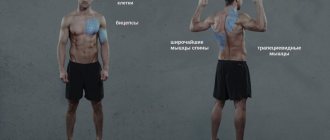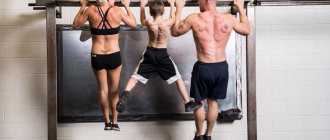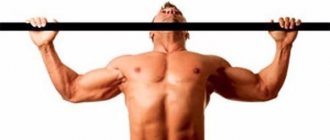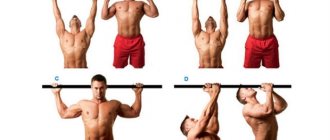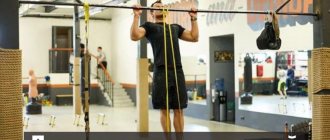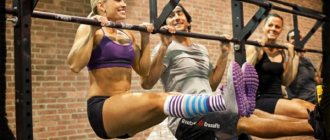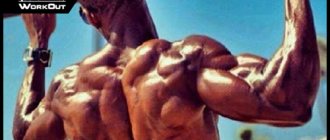Every self-respecting man should have a powerful back, but not everyone has the opportunity to go to a rocking chair. But there is a way out. Almost every yard has horizontal bars, and a horizontal bar is one of the best cures for skinny back syndrome.
Today I will tell you how to transform your frail back, which cannot even bear the weight of a cap, into a powerful and wide back, behind which a small Chinese family of twenty-three people can hide. In short, read about how to pump up your back on the horizontal bar.
Is it possible to pump up your back on the horizontal bar?
It’s possible to pump up your back on the horizontal bar; I would even say that this is a very good way. After all, pull-ups are one of the best exercises that will stretch your back to unprecedented levels.
But all your impulses to pump up your back with pull-ups will be in vain if your nutrition is no more than that of a newly hatched chicken.
If you want a powerful back, then you definitely need to eat like two healthy bulls. The fact is that for muscle growth you need enough nutrients , and in order for you to have the strength to lift your frail body to the bar, you need energy, which you will take from the same food.
I described all the nuances in more detail in the article about nutrition for weight gain.
Useful tips for those who want to increase their back muscles
You won't be able to increase your back muscles with pull-ups alone. Athletes are advised to adhere to several rules:
- It is almost impossible to increase any one muscle. The most effective way is the organic and proportional development of the whole body.
- Muscle growth is only possible with an actual calorie surplus.
- You should definitely include pull-ups in your back workout. First of all, a regular grip and a wide grip are used.
- Don't limit yourself to just pull-ups. If possible, it is advisable to diversify the training process with exercises with a barbell, dumbbells and various rows on the upper and lower blocks.
- When performing pull-ups, do not rock your body. It is important to load the desired muscle with each movement.
- If it becomes easy to do more than 12 pull-ups for 4 sets, it is recommended to use additional weight. You can start with 5 kilograms and gradually increase it.
A wide back is the dream of many athletes. It will highlight the waist and make the athlete’s appearance proportional and strong. When developing this muscle group, it is imperative to include pull-ups in the program, of which there are several types. They allow you to significantly work out the latissimus, trapezius, as well as other muscles of the back and other muscle groups. The movement is considered basic and seems to be quite effective both when gaining weight and when working on relief.
How to do pull-ups correctly?
I often see that many guys don’t get off the horizontal bar for days on end, but a wide back remains only in their imagination. And the whole problem is that they pump everything except the back.
To pump up your back on the horizontal bar, you need to pay great attention to technique when doing pull-ups. If you perform the exercise technically incorrectly, then mainly your arms will work, and your back will either receive too little load or not receive it at all.
To feel your back in pull-ups, you need to think about your back and concentrate all your attention on it. You need to bend over and reach your chest towards the bar, and not try to peck it with your nose.
I also often see that many guys do pull-ups with a very slouched position. Only the arms work this way, because the back muscles do not contract at all.
If you want to build a powerful back on the horizontal bar, then remember the basic rules of pull-ups :
- Reach the bar with your chest.
- Bring your shoulder blades together, pull your shoulders back.
- Do it smoothly, without jerking, pay more attention to the negative phase.
You can also do pull-ups with different grips to work more muscle fibers. Any other angle will engage a new muscle, and there are actually quite a lot of options for pull-ups, for example:
- wide straight grip to the chest;
- wide straight grip on the head;
- narrow reverse grip to the chest;
- narrow parallel grip.
Another good incentive for back growth will be increasing the load.
If it’s already easy enough for you to do pull-ups and you do more than 15 pull-ups with your own weight, then you can take away a backpack full of heavy textbooks from some schoolchild and start doing pull-ups. Increasing the load will provide your body with stress and give an impetus to growth.
If possible, if I were you, I would take a vest that you can add weights to. It is more convenient to exercise in it, and you will be able to increase weight for quite a long time.
Now that you've learned how to do pull-ups properly to build up your back, let's move on to a training program that will help you move from theory to practice.
Exercise technique
When performing exercises that will pump up your back muscles, it is important to remember the following.
- For maximum load, you need to perform the exercises smoothly: without jerking or sudden jolts. This creates a static load that the muscles are not used to dealing with, and helps to strengthen them and increase their volume.
- The latissimus dorsi muscles become shorter after each workout. To avoid this, stretch your back muscles after performing exercises.
- Pay attention to which muscles receive the greatest load. When performing back exercises, there is a high risk of transferring the load to the arm muscles, which will reduce the effectiveness of the workout.
Pull-up program on the horizontal bar and parallel bars
As I said earlier, in order to work all the back muscles on the horizontal bar to the maximum, you need to pump it from different angles.
To do this you need to use different exercises. Therefore, now I will give an example of a program using only a horizontal bar and parallel bars , which will make your back so wide that when you stand in front of the sun, your entire city will be plunged into darkness:
- Wide-grip chest pull-ups: 5 sets of 6-12 reps.
- Pull-ups with a parallel close grip to the chest: 5 sets of 6-12 reps.
- Pull-ups with a wide grip behind the head: 5 sets of 6-12 reps.
- Pull-ups (with your legs on the bars) 5 sets of 6-12 reps.
You need to rest for about 1.5-2 minutes between sets. If it's easy for you and you can do more than 12 pull-ups, then it's time to add a little extra weight.
Back muscles: anatomical information
The back muscles are conventionally combined into one muscle group, but in fact the back is a complex of different muscles, each of which performs its own separate function. A general purpose can also be highlighted: thanks to them, a person gained the ability to walk upright, the spine was protected from various injuries and overloads. The back muscles are also used when lifting loads and the weight of a person’s own body.
Each individual muscle is activated depending on the movement being performed. So, when extending the torso, the lower back muscles are first involved in the work, when doing pull-ups - the upper back, and so on.
Main back muscles:
- Transverse spinous muscles. They consist of the rotator cuff muscles, as well as the semispinalis and maltifidus muscles. In essence, such muscles ensure the movement of individual vertebrae and are responsible for the stability of the spine and its safety.
- Extensors. Among them are the iliocostalis muscle, the spinalis muscle and the longissimus muscle.
- Upper back muscles. These are the trapezius muscles, the muscles responsible for lifting the scapula, and also the rhomboid muscles. They are responsible for the movements of the shoulder girdle, the reduction of the shoulder blades, and the movement of the head.
- Lat. The main function is to bring the shoulder towards the body.
- Square lumbar. Allows you to tilt to the side.
Each muscle located on the back is responsible for a specific movement.
How are regular pull-ups different from back pull-ups?
In the classic form of this exercise, not only the back muscles are involved, but also the muscles of the arms, shoulders and core. However, if your goal is to have a wide back, then you need to use a slightly modified exercise.
Unfortunately, when doing back pull-ups, the arm muscles are not completely isolated and are also included in the work, but the main task is performed by the right muscles. The back muscles are involved in different types of pull-ups; the main ones will now be described.
Classic pull-ups
As described earlier, this type of exercise involves not only the back muscles, but also the arm muscles. Nevertheless, the muscles we need are also included in the work. This method is well suited for those who have just started their training or for warming up for more experienced athletes.
I am sure that many have been familiar with this exercise since childhood, when they were forced to do pull-ups in physical education classes. However, not everyone knows the correct technique, which we will now discuss.
What not to do when doing pull-ups on a horizontal bar?
Don't throw your head back sharply. Many beginners, who do not have enough strength to fully complete the exercise, tilt their head back in the hope of touching the bar with their chin. It is not right. This action can lead to injury to the cervical vertebrae if they are not well stretched.
Also, you shouldn’t do this, because in essence, you are simply deceiving yourself. If you cannot complete the last pull-up on your own, you should not try to do this by using other parts of the body.
Don't exhale when doing pull-ups
This error, like the previous one, is typical mainly for beginners. They are the ones who exhale when lifting their body up on the bar, considering this to be the correct technique for performing the exercise. This is wrong! If you exhale while pulling up, you can injure the muscles located near the shoulder blade. The injury is very painful and any movement of the body during it will result in an unpleasant sensation in the tissues. This injury is common among gymnasts who cannot always monitor their breathing while performing a number of exercises.
When doing pull-ups, it is recommended not to exhale, but rather fill your chest with air and hold your breath. This action facilitates the work of the latissimus dorsi muscles and you will complete the exercise with less effort.
Don't force yourself
Some inexperienced athletes perform pull-ups not using their back muscles, but by pushing their bodies independently. In gyms and playgrounds you can often see such a picture when some beginner is trying to squeeze out the last 5 pull-ups, while squirming like a worm on a horizontal bar.
Is it possible to talk about some kind of muscle development and progress with such a technique? Of course not! This makes it easier to get injured or tear a muscle. Remember, any physical exercise aimed at progressing in training should be performed smoothly and without jerking. When the pull-up is artificially completed, the back muscles stop working. You should lower and rise only by moving your elbows.
However, when it comes to back pull-ups, the first thing that comes to mind is doing this exercise behind your head. That is, when your head is almost at the level of the bar, you tilt it slightly, as if trying to touch the bar with your back.
And this is indeed true - this type of pull-up is very good for pumping up the muscles we need. In this case, the arm muscles are practically disabled and the back muscles do the main work. Now let's take a closer look at the technique of performing this exercise.
Useful tips for training
Intermediate and advanced bodybuilders often treat the bar as an easy exercise and neglect to warm up.
This is a mistake that can result in serious injury!
During pull-ups, a large load falls on the shoulder joints. They are quite fragile and easily injured.
Shoulder injuries mean a complete stop to your entire upper body training. Until they recover, you will not be able to fully work out your chest, back, or arms.
Therefore, before starting work on the horizontal bar, warming up is mandatory!
Another small but important point:
Using straps or gloves when doing pull-ups strengthens your grip and makes the exercise more technical, with more repetitions.
This is a plus for lat growth, but a huge minus for forearms.
They do not receive the necessary load, which leads to an imbalance in their muscle development.
It takes a long time and persistently to eliminate the “lag” of the forearms with special training.
Avoid using gloves and straps! Work on the horizontal bar with your bare hands.
If your palms slip, use magnesium. This is exactly what they do in gymnastics and strength sports.
In this case, in parallel with the increase in the volume and strength of the lats, your forearms will strengthen and develop. And in the future there will be no need to correct the imbalance in their development.
You will succeed!
By following these simple tips, you can seriously develop your body without spending extra money.
Remember, you don't need to go to the gym, consult with trainers or use sports supplements.
The hour is not far off when you will be able to do pull-ups no worse than professional athletes who film their workouts.
Muscles involved
Pull-ups on the horizontal bar in general are one of the most effective exercises for the back. A wide grip allows you to load the upper part of the latissimus muscle, which is largely responsible for the visually wide back.
So, what muscles work first:
- widest;
- diamond-shaped;
- big round.
Additional muscles (assistants) work:
- pectoralis major and minor;
- shoulder muscles;
- biceps.
Schemes and types of training
With different training schemes and loads, the training process can be divided into three completely different principles, each of which has the right to life.
Pull-ups on a horizontal bar for the back are suitable for every person; only the training scheme changes depending on the starting characteristics and the availability of free time. But there are a few simple rules.
Forget about doing lots of sets and reps every day. In an attempt to create unique media content, many athletes, coaches and bloggers try to deviate from proven recipes and surprise the viewer.
They organize so-called “challenges”, show in their videos results that are questionable from the point of view of the purity of the experiment, and even dangerous for an unprepared person, practicing every day.
At the same time, they may have a specific diet - a vegetarian diet, a “raw food diet”, practically not consuming carbohydrates and protein.
With this regime, the muscles will not have time to recover, over time, overtraining will occur, and instead of progress, at best you will remain stagnant. At worst, you will lose the results achieved previously.
Moreover, overly active activities pose a risk of injury. The most common of them are elbow and shoulder.
At the initial stage, you should not make complex variations, learned from truly professionals.
Regarding the schemes themselves:
- In the first case, you need to load your back muscles with a similar exercise no more than once or twice a week, combining this load with other types of training.
- In another, the main emphasis is on working with a horizontal bar; the exercise is performed in isolation for a certain period of time, 3-4 times a week.
- The third type involves 3-4 single loads, but throughout the day with a large rest interval (about 1 hour), dividing the load into 8-10 approaches.
For what diseases of the spine can you exercise on the horizontal bar?
In order to prevent the health of the spine and treat pathologies of the spinal column, exercises on the horizontal bar can be practiced in the absence of contraindications.
Diseases for which exercises on the horizontal bar are prescribed are most often associated with the destructive development of the vertebrae:
- osteochondrosis (lumbar or thoracic). Systematic stretching of the intervertebral spaces helps to normalize blood circulation in the cartilage and disc structures, as well as relax the paravertebral muscle fibers. By increasing the interdisk space, the possibility of pinching of blood vessels and nerve endings is prevented;
- kyphosis _ Involves hanging on a bar to stretch and align the spine. With kyphosis, reverse grip on the tunic is contraindicated, but with proper and constant exercise, the spine can gradually align;
- lordosis . Correction of curvature is possible with regular hanging on the horizontal bar and other additional exercises;
- ischemia of intervertebral discs . Stretching, swinging with a small amplitude and hanging on the horizontal bar helps to align the location of disc structures and vertebrae, due to which compression of nerve fibers and blood vessels is eliminated, and the condition of the intervertebral discs improves.
Exercises on the horizontal bar for the treatment of specific diseases, the intensity and nature of the exercises should be determined by a qualified specialist in accordance with the stage of the disease. Most often, physical therapy is an addition to the complex treatment of diseases of the spinal column.
Video: “Pull-up bar for osteochondrosis”
Top 6 exercises on the abdominal bar
"Frog"
Classic technique of exercise for the lower abs on the horizontal bar.
- It will get rid of folds on the stomach and tighten the buttocks.
- Stimulating blood flow in the pelvis promotes erection.
Technique:
- Hanging on the horizontal bar, we pull the bent legs towards the stomach;
- after a 3 second pause, slowly raise it to the chest.
Let’s make it more difficult: after the next delay, we move our knees towards our chin and try to hold on longer.
- Men perform 15 times in 4 approaches.
- Girls are 2 times smaller.
With each workout, increase the number of pull-ups by 1 rep.
Hanging Leg Raises for Abs
Exhausting practice for the lower abs. Recommended for experienced athletes as an alternative to knee raises.
- We cling to the crossbar. If your grip is weak, the straps will come in handy.
- With a strong movement from a free hang, we pull straight legs horizontally upward to the optimal height. To increase tension, we lift together with the pelvis.
- After a pause, return to the starting position.
If you get bored, pull your knees up until they touch your elbow joints.
No body swaying! Movements are performed only by the abdominal muscles.
When the body relaxes, a burning sensation should be felt throughout the body. To “finish off” the abs, hold the “corner” until your palms begin to unclench.
Girls perform with bent knees. To comfortably go through the lifting phase, first slightly move the limbs back.
We remember that the abdominal muscles begin to work intensively after crossing the 45⁰ mark.
This technique on the abdominal bar is performed at the beginning of the program - 15-20 repetitions in 3-4 approaches.
U-turns
Standard hanging crunches pump up the oblique abdominal muscles.
- We pull our knees to our chest like in a “frog”;
- We turn the body to the left and right sides.
The practice is not relevant for girls, since it smooths out the side curves and the waist becomes flat (30 x 3).
Pirouette
An advanced exercise for men to develop strength and abdominal muscles.
- We cling to the crossbar with a medium straight grip;
- raise the body until the chin crosses the bar;
- throw our legs up;
- We perform a lift with an inversion, hanging on outstretched arms.
5. Exercise “Windshield wipers”, “bicycle” or “tick-tock”
- In the canopy position, we raise our legs at an angle of 45⁰ (to the pelvic line).
- Alternately move the left and right to the sides without holding your breath.
- An alternative is to simulate riding a bicycle. Don't forget to increase the amplitude of your swings.
- We pull the body up, crossing the limbs (“scissors”) as we go.
- An option for those who are prepared - we stretch our toes towards the bar.
- We leave one brush on the bar, the other on the side stand. The lower the hand position, the more difficult the work. We are trying to raise our legs with a “corner”.
Upside down
To load the upper abs, we hang upside down.
- We press the bar with our knees.
- We are trying to pull the body towards them.
- At the point where the body bends, we pause for a second.
- With your hands folded at the back of your head, you can make turns to the sides.
For athletes with “steel” muscles, there are special devices that allow you to hang upside down and lift your torso from the bottom position. Read more about gravity boots →
For greater effect, wear a vest with a load. The main thing is not to overexert yourself, to maintain consistency in increasing the pace.
